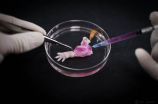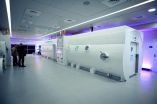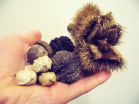(Press-News.org) San Antonio -- June 2, 2015 -- A close-up of Comet 67P/Churyumov-Gerasimenko by NASA's ultraviolet instrument surprised scientists by revealing that electrons close to the comet's surface -- not photons from the Sun as had been believed -- cause the rapid breakup of water and carbon dioxide molecules spewing from the surface.
Since last August, the European Space Agency's Rosetta spacecraft has orbited within a hundred miles of the comet in this historic mission. The spectrograph onboard, named Alice, specializes in the far-ultraviolet wavelength band and was developed by Southwest Research Institute (SwRI). Alice examines light the comet is emitting to understand the chemistry of the comet's atmosphere, or coma. A spectrograph is a tool astronomers use to split light into its various colors. Scientists can identify the chemical composition of gases by examining their light spectrum. Alice is the first such far-ultraviolet spectrograph to operate at a comet.
"The discovery we're reporting is quite unexpected," said Alice instrument Principal Investigator Dr. Alan Stern, an associate vice president in SwRI's Space Science and Engineering Division. "It shows us the value of going to comets to observe them up close, since this discovery simply could not have been made from Earth or Earth's orbit with any existing or planned observatory. And, it is fundamentally transforming our knowledge of comets.
"Analysis of the relative intensities of observed atomic emissions allows us to determine that we are directly observing the 'parent' molecules that are being broken up by electrons in the immediate vicinity, about 1 kilometer, of the comet's surface from which the parent molecules are vaporizing," said Dr. Paul Feldman, professor of physics and astronomy at the Johns Hopkins University in Baltimore, Maryland.
Feldman is lead author of the paper, "Measurements of the Near-nucleus Coma of Comet 67P/Churyumov-Gerasimenko with the Alice Far-ultraviolet Spectrograph on Rosetta," which has been accepted for publication in the journal, Astronomy and Astrophysics.
Much of the water and carbon dioxide originates from "plumes" erupting from the comet's surface, similar to those that the Hubble Space Telescope discovered on Jupiter's moon Europa, noted co-author Dr. Joel Parker, an assistant director in SwRI's Space Science and Engineering Division's Boulder, Colo., office.
Based on the new Alice data reported in the paper, the explanation for the breakup of those molecules is similar to that for the plumes on Europa, except that the electrons at the comet are produced by solar radiation, while the electrons at Europa come from Jupiter's magnetosphere, Feldman said.
Parker added, "By looking at the emission from hydrogen and oxygen atoms broken from the water molecules, we also can actually trace the location and structure of water plumes from the surface of the comet."
The far-ultraviolet region of the spectrum allows scientists to detect the most abundant elements in the universe: hydrogen, oxygen, carbon and nitrogen. However, Feldman noted such measurements must be made from outside the Earth's atmosphere, either from orbiting observatories such as the Hubble Space Telescope, or from planetary missions such as Rosetta. From Earth's orbit, the atomic constituents can only be seen after their "parent" molecules, such as water and carbon dioxide, have been broken up by sunlight, hundreds to thousands of kilometers away from the nucleus of the comet.
The Alice spectrograph aboard Rosetta has also studied the surface of Comet 67P/ Churyumov-Gerasimenko and will be used in further studies of its atmosphere as the comet approaches the Sun and its plumes become more active due to solar heating.
Rosetta-Alice is one of two ultraviolet spectrographs named "Alice" currently flying in space. The other is New Horizons-Alice. Rosetta-Alice is operated by SwRI under contract with the Jet Propulsion Laboratory/California Institute of Technology for the National Aeronautics and Space Administration. Alice is studying the coma and surface of Comet 67P/Churyumov-Gerasimenko to understand the formation and evolution of comets and the nature of cometary activity, and to connect activity of the nucleus with changes in the coma and tail, as well as interactions with the solar wind.
INFORMATION:
Editors: Image to accompany this story: http://www.swri.org/press/2015/alice-rosetta.htm.
Menopausal hormone therapy (MHT) given to recently postmenopausal women in the US for up to four years does not improve cognition, but may have some positive benefits for some mood symptoms, according to a study published by Carey Gleason and colleagues from the University of Wisconsin, Madison, USA, in this week's PLOS Medicine.
The researchers reached these conclusions by conducting a randomized placebo-controlled clinical trial (the KEEPS-Cog trial), including 693 recently postmenopausal women living in the US who were randomly assigned to receive either oral estrogen ...
What if your doctor told you that your weight is somewhere between 100 and 400 lbs.? With any ordinary scale every patient can do better at home. Yet, one patient can't: the Milky Way. Even though today we peer deeper into space than ever before, our home galaxy's weight is still unknown to about a factor of four. Researchers at Columbia University's Astronomy Department have now developed a new method to give the Milky Way a more precise physical checkup.
The Milky Way consists of roughly 100 billion stars that form a huge stellar disk with a diameter of 100-200 thousand ...
PHILADELPHIA--(June 2, 2015)--Senescence, a phenomenon in which cells cease to divide and grow, can be caused by everything from natural DNA damage to treatment with chemotherapy. However, several mechanisms allow for cells to bypass senescence and grow out of control, eventually becoming cancerous. Now, scientists at The Wistar Institute have identified how a specific variant of a key protein complex found in human cells called condensin can reorganize a cell's genetic architecture in such a way as to promote senescence, making it an important facilitator in a cell's ...
A team of Massachusetts General Hospital (MGH) investigators has made the first steps towards development of bioartificial replacement limbs suitable for transplantation. In their report, which has been published online in the journal Biomaterials, the researchers describe using an experimental approach previously used to build bioartificial organs to engineer rat forelimbs with functioning vascular and muscle tissue. They also provided evidence that the same approach could be applied to the limbs of primates
"The composite nature of our limbs makes building a functional ...
Who says you can't do two things at once and do them both well?
A new University of Florida study challenges the notion that multi-tasking causes one or both activities to suffer. In a study of older adults who completed cognitive tasks while cycling on a stationary bike, UF researchers found that participants' cycling speed improved while multi-tasking with no cost to their cognitive performance.
Results of the study, which was supported by a grant from the National Institute on Aging, were published May 13 in the journal PLOS ONE.
The discovery was a surprise finding ...
COLUMBUS, Ohio - A new nationwide study reveals that the kind of cities that attract college graduates has changed since the 1990s.
In the 1990s, grads were moving to cities with fast-growing "smart" industries in fields like high tech, the study found. But since 2000, with a less vibrant national economy, college graduates are flocking toward the biggest cities with the biggest labor markets and the best chances of landing a job.
In fact, the effect of city population size in attracting college grads was nearly four times as large in the 2000s as it was in the 1990s, ...
(New York, NY, June 1, 2015)-- The Big Apple is one of the most walkable cities in the nation, providing many opportunities for physical activity, and New Yorkers are more likely to exercise regularly than the average U.S. adult. But they are also sitting far more than what is considered healthy.
According to a new study published by the U.S. Centers for Disease Control and Prevention in its journal Preventing Chronic Disease, the average New York City resident sits more than seven hours a day--greatly exceeding the three hours or more per day that is associated with ...
HOUSTON - (June 2, 2015) - Hispanics and women in Texas showed the largest percentage of reductions in rates of uninsured since enrollment began in the Affordable Care Act's (ACA) Health Insurance Marketplace, according to a new report released today by the Episcopal Health Foundation and Rice University's Baker Institute for Public Policy.
The report found that from September 2013 to March 2015, the percentage of Hispanics without health insurance fell 38 percent (from 39.1 percent uninsured to 24.3 percent), more than any other ethnic group. The percentage of uninsured ...
HOUSTON - (June 2, 2015) - Women who suffer from fibromyalgia benefit from a treatment regimen in a hyperbaric oxygen chamber, according to researchers at Rice University and institutes in Israel.
A clinical trial involving women diagnosed with fibromyalgia showed the painful condition improved in every one of the 48 who completed two months of hyperbaric oxygen therapy. Brain scans of the women before and after treatment gave credence to the theory that abnormal conditions in pain-related areas of the brain may be responsible for the syndrome.
Results of the study ...
BUFFALO, N.Y. -- A new study by University at Buffalo geographers explores how humans altered the arboreal make-up of Western New York forests before European settlers arrived in large numbers.
The research looked at land survey data from around 1799-1814, and used this information to model which tree species were present in different areas of Chautauqua County, New York, at that time.
The analysis placed hickory, chestnut and oak trees in larger-than-expected numbers near the historical sites of Native American villages, said co-author Steve Tulowiecki, who conducted ...


